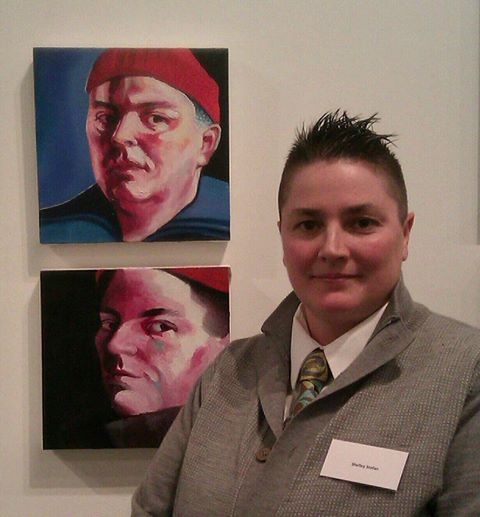Print Edition: February 5, 2014

“I’ve fallen back in love with the human face, and how you can come at it many different ways. It’s just so beautiful. It doesn’t matter who the person is.”
I’m talking to professor Shelley Stefan in her tiny UFV office. Although it can’t be more than a dozen feet square, it’s at least twice as tall as it is wide. The walls are covered with charcoal sketches and other media, spreading out collage-like from top-to-bottom. She invites me to sit on her squashy pink sofa as I interview her, but warns me not to lean back — the charcoal is still alive, ready to smudge on clothing and walk out of the office.
“In the ‘90s, as a university student, I did hundreds and hundreds of portraits, and lots of self-portraits,” she says.
She talks with her hands, and upbeat marimba music plays in the background.
“It’s all about the human face, and artwork that is able to get something across of the human spirit, just through the human face. You can draw or paint a face, and it’s just representational. But this was more about the essence of the human inside.”
Two of Stefan’s tiny one-foot-square self-portraits are part of a larger exhibit, About Face, in North Vancouver’s CityScape Community Art Space. They share the space with the work of 28 other artists — all faces.
“It was neat to see my work in a family of other works that were all really different,” she says. Hers were some of the smallest, but others were large, provocative. Where Stefan’s are realistic, others are abstract.
“Range,” Stefan says, concluding. “A wide range.”
The exhibit is a North Vancouver Community Arts Council project, which put a call out for works to western Canadian artists after a member pitched the idea for a show based only on portraiture. Stefan submitted five works, and received a letter of acceptance for two of them.
The process, she says, was a lot like applying for a job.
“They looked at your artist statement, your CV, your experience in the arts,” she lists, counting off the documents on her fingers.
“Also — obviously the most important part —” she adds, “the work.”
The small oil-on-canvas self-portraits the council accepted, she says, are a part of a larger project. She hopes to have maybe a hundred self-portraits painted by the end of this year.
Stefan has a cabin by a lake in the valley, where she retreats to study and paint. It sounds idyllic, and it is – she stokes the wood stove, puts on CBC Radio 2, and returns to old-school methods of painting; oil, canvas, mirror, light.
“No photography, just hand-eye coordination and on-site observation,” she says. “It’s harder that way. It’s harder, and it’s old-school, but it’s really enjoyable.”
“Sometimes when I paint, even self-portraits, I feel I can see my ancestors, and my ancestors’ ancestors,” she adds. “It’s just this really powerful sort of sublime, introspective, academic exercise.”
Her passion for and interest in portraiture was rekindled in part when she began to teach at UFV.
“If I’m telling students how to draw or how to paint, you can’t really learn that way — you have to learn through doing. You have to learn through watching and being done,” she says. “It’s visual; it’s experiential; you have to do the artwork but you can also watch someone else do it.”
She’ll often “whip up” a study of a face using herself, or a student, or a model, showing her students how to draw the lines out of a face. If you capture the gaze just right, she says, the portrait will come alive.
It’s these works — the ones that capture the human spirit — that most speak to Stefan, and this is part of what About Face tries to show.
She hopes that her two small portraits pull the viewer into the moment of a single breath — the moment as she paused and turned from mirror to canvas.
“All they’re doing is looking at you,” she says, a small and pleased smile hovering about her mouth. “But there’s this level of connection — like when someone gives you eye contact, the whole feeling changes. You can walk by a person, but if they stop and give you even three seconds of eye contact, something shifts.”
This is something in a portrait that endures; decade after decade and century after century, artists return again and again to the humanness of a face.
“When you see paintings from the 1200s or the 1400s and they’re so full of life that they could be alive right now … it’s unbelievable that they were done so long ago,” Stefan says.
“I really like that: the breathing human.”

